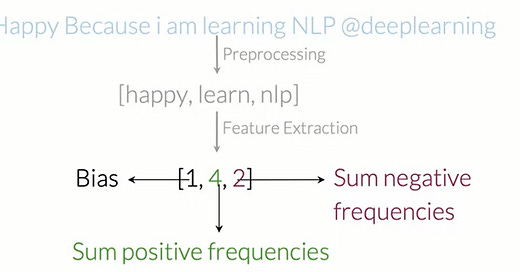Step-by-Step Guide to Building an X Matrix for NLP Sentiment Analysis Using Python
📚Chapter 2: Sentiment Analysis (logistic Regression)
If you want to read more articles about NLP, don’t forget to stay tuned :) click here.
Putting it All Together
You will now use everything that you learned to create a matrix that corresponds to all the features of your training example. Specifically, I will walk you through an algorithm that allows you to generate this x matrix.Let’s take a look at how you can build it.
General Overview
Previously, you saw how to preprocess a tweet like this one to get a list of words that contain all the relevant information for the sentiment analysis tasks in NLP. With that list of words, you would be able to get a nice representation using a frequency dictionary mapping. And finally, get a vector with a bias unit and two additional features that store the sum of the number of times that every word on your process tweets appears in positive tweets and the sum of the number of times they appear in negative ones.
In practice, you would have to perform this process on a set of m tweets. So given a set of multiple raw tweets, you would have to preprocess them one by one to get these sets of lists of words one for each of your tweets. And finally, you’d be able to extract features using a frequencies dictionary mapping. At the end, you would have a matrix, X with m rows and three columns where every row would containthe features for each one of your tweets.
General Implementation
The general implementation of this process is rather easy. First, you build the frequencies dictionary, then initialize the matrix X to match your number of tweets. After that, you’ll want to go over through your sets of tweets carefully deleting stop words, stemming, deleting URLs, and handles and lower casing. And finally, extract the features by summing up the positive and negative frequencies of the tweets. For this week’s assignment, you’ve been provided some helper functions, build_freqs and process_tweet. However, you’ll have to implement the function to extract the features of a single tweet. That was a lot of code, but at least now you have your X matrix. And in the next video, we will show youhow you can feed in that X matrix into your logistic regression classifier. Let’s take a look at how you can do that.
Let’s connect: If you found this helpful, share your thoughts or questions in the comments! 😊
Please Follow and 👏 Subscribe courses teach to see latest updates on NLP
🚀 Elevate Your Data Skills with Coursesteach! 🚀
Ready to dive into Python, Machine Learning, Data Science, Statistics, Linear Algebra, Computer Vision, and Research? Coursesteach has you covered!
🔍 Python, 🤖 ML, 📊 Stats, ➕ Linear Algebra, 👁️🗨️ Computer Vision, 🔬 Research — all in one place!
Don’t Miss Out on This Exclusive Opportunity to Enhance Your Skill Set! Enroll Today 🌟 at
Natural Language Processing with Probabilistic models Resources Course
Natural Language Processing Resources course
🔍 Explore cutting-edge tools and Python libraries, access insightful slides and source code, and tap into a wealth of free online courses from top universities and organizations. Connect with like-minded individuals on Reddit, Facebook, and beyond, and stay updated with our YouTube channel and GitHub repository. Don’t wait — enroll now and unleash your NLP potential!”
Stay tuned for our upcoming articles where we will explore specific topics related to NLP in more detail!
Remember, learning is a continuous process. So keep learning and keep creating and sharing with others!💻✌️
We offer following serveries:
We offer the following options:
Enroll in my Computer Vision course: You can sign up for the course at this link. The course is designed in a blog-style format and progresses from basic to advanced levels.
Access free resources: I will provide you with learning materials, and you can begin studying independently. You are also welcome to contribute to our community — this option is completely free.
Online tutoring: If you’d prefer personalized guidance, I offer online tutoring sessions, covering everything from basic to advanced topics.
Contribution: We would love your help in making coursesteach community even better! If you want to contribute in some courses , or if you have any suggestions for improvement in any coursesteach content, feel free to contact and follow.
Together, let’s make this the best AI learning Community! 🚀
Source
1- Natural Language Processing with Classification and Vector Spaces







